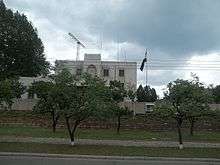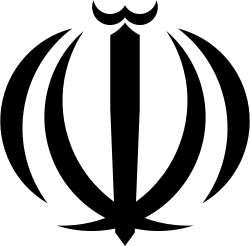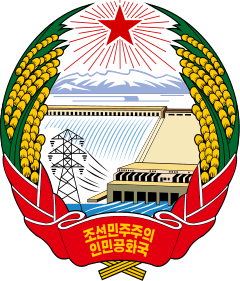Iran–North Korea relations
Iran–North Korea relations (Korean: 이란-조선민주주의인민공화국 관계; Persian: روابط ایران و کرهی شمالی) are described as being positive by official news agencies of the two countries. Diplomatic relations improved following the Iranian Revolution in 1979 and the establishment of an Islamic Republic. Iran and North Korea pledge cooperation in educational, scientific, and cultural spheres.[1] Some media reports claim this cooperation extends to nuclear cooperation,[2] though official U.S. government publications[3] and academic studies have disputed this.[4] The United States has been greatly concerned by North Korea's arms deals with Iran, which started during the 1980s with North Korea acting as a third party in arms deals between the Communist bloc and Iran, as well as selling domestically produced weapons to Iran, and North Korea continues selling missiles to Iran. North Korea and Iran are the remaining two members of George W. Bush's "Axis of evil", which has led to many of the concerns regarding Iran–North Korea relations.
 | |
North Korea |
Iran |
|---|---|
| Diplomatic mission | |
| North Korean Embassy, Tehran | Iranian Embassy, Pyongyang |
| Envoy | |
| Ambassador Kang Sam-hyon | Ambassador Seyed Mohsen Emadi |

The United States of America designates both nations as State Sponsors of Terrorism, and they reciprocate this shared enmity. Despite this, Iran is one of the only countries in the world that has a good relationship with both North and South Korea.
History
The Persian-Korean relationship started with cultural exchanges date back to the Three Kingdoms of Korea era, more than 1600 years ago by the way of the Silk Road. A dark blue glass was found in the Cheonmachong Tomb, one of Silla's royal tombs unearthed in Gyeongju, and an exotic golden sword was found in Gyerim-ro, a street also located in Gyeongju. These relics are presumed to have been sent to Silla from ancient Iran or Persia through the Silk Road. It was only the Koryeo Dynasty during King Hyeonjong's reign when trade with Persia was officially recorded in Korean history. But in academic circles, it is presumed that both countries had active cultural exchanges during the 7th century Silla era which means the relationship between Korea and Iran dates to 1500 years ago. "If a history book written by the Persian scholar Khurdadbid, it states that Silla is located at the eastern end of China and reads 'In this beautiful country Silla, there is much gold, majestetic cities and hardworking people. Their culture is comparable with Persia'.[5]
Other items uncovered during the excavation include a silver bowl engraved with an image of the Persian goddess Anahita; a golden dagger from Persia; clay busts; and figurines portraying Middle Eastern merchants. Samguk Sagi—the official chronicle of the Three Kingdoms era, compiled in 1145—contains further descriptions of commercial items sold by Middle Eastern merchants and widely used in Silla society.[6]
Throughout the years, the Imperial State of Iran had no relations with the Democratic People's Republic of Korea in its early years, particularly due to Iran having relations with the Republic of Korea that were established in 1962. Both countries were allied in the U.S.-led Western Bloc during the Cold War. In 1979, the pro-U.S. monarchy was deposed and was replaced with an Islamic Republic.
Despite the two countries' shared antagonism to U.S. foreign policies, the specific national interests of the North Korea and the Islamic Republic of Iran were often considerably different from each other. For instance, North Korea, though it provided Iran with military assistance during the Iran–Iraq War (an act that induced Baghdad to break diplomatic relations with Pyongyang), made repeated attempts to normalize its relations with the Iraqi government.[7] In 1982, the North Korean authorities secretly invited an Iraqi delegation to Pyongyang, but the Iraqi government sent only an unofficial representative. The talks failed, but the attempt revealed that North Korea was not ideologically committed to Iran's crusade against Saddam Hussein. The Iranian leaders decided to maintain diplomatic relations with both North and South Korea. During the recent inter-Korean security crises (like the ROKS Cheonan sinking and the Bombardment of Yeonpyeong), Iranian news agencies usually quoted the statements of the Korean Central News Agency in parallel with the statements made by Western and South Korean politicians, without showing any detectable preference for either side.[8]
Nor were the two states in full concord in adopting a position toward the various manifestations of international terrorism. On the one hand, both Iran and the North Korea provided military assistance to Hezbollah in Lebanon, and they actively sided with the totalitarian nationalist Arab leadership Bashar al-Assad against the Syrian wing of the Islamic State of Iraq and the Levant during the Syrian Civil War. North Korea and Iran held substantially different views about the conflicts in which the Taliban, the Boko Haram, and the Iraqi wing of ISIL were involved. While the North Korea stressed that U.S. efforts to suppress these organizations constituted interference in the internal affairs of Afghanistan, Nigeria, and Iraq, the Iranian leaders, who regarded Sunni Salafi extremism as a direct threat to their own interests, repeatedly accused America of not striving hard enough to eliminate these groups or even seeking to reach an agreement with them.[9][10]
Ambassadors
List of North Korean ambassadors to Iran
List of Iranian ambassadors to North Korea
Military weapons
Since the 1980s North Korea has become known as a reliable supplier of arms to other countries including Iran. Weapons sales between North Korea and Iran increased significantly during the Iran-Iraq war.[21] This weapons sale relationship has expanded into further military cooperation including in the development of and exchange of nuclear technology. This relationship has also involved Syria.[22][23]
During the Persian Gulf War North Korea is said to have supplied Iran with a range of arms including artillery, anti-aircraft machine guns, mortars, ammunition, tanks, small arms, naval mines and anti-tank and surface-to-air missile systems.[24] In December 2009, in contravention of an arms embargo imposed on North Korea, a shipment of North Korean arms, said to be en route for Iran, according to the Congressional Research Service, was intercepted in Thailand.[25][26] These weapons included rocket launchers and surface-to-air missile parts.[25]
In addition to weapons, North Korea and Iran have an active exchange of military expertise particularly in relation to special operations and underground facilities.[22] North Korea is thought to have trained Iranian operators in these advanced infiltration techniques.[22]
In March 2013 North Korea and Iran, as well as Syria, blocked a UN Arms Trade Treaty[27] aimed at setting "standards for all cross-border transfers of conventional weapons".[28]
Arms expert Jeffrey Lewis claims that the second stage of North Korea's Hwasong-14 ICBM is similar to the upper stages designed for the Iranian space launch vehicles.[29]
References
McEachern, Patrick and Jaclyn O'Brien McEachern. North Korea, Iran and the Challenge to International Order (Routledge, 2017). https://www.routledge.com/North-Korea-Iran-and-the-Challenge-to-International-Order-A-Comparative/McEachern-McEachern/p/book/9781138295124
Fitzpatrick, Mark. Iran and North Korea: The Proliferation Nexus. Survival, Vol. 48, No. 1 (2006), pp. 61–80.
Levkowitz, Alon. Iran and North Korea Military Cooperation: A Partnership within the 'Axis of Evil'. Iran-Pulse 10 (2007), pp. 1–3: https://web.archive.org/web/20150107132716/http://humanities.tau.ac.il/iranian/en/previous-reviews/10-iran-pulse-en/117-10 .
- "Result of Iranian delegation visit to N Korea positive". IRNA. 23 January 2007. Archived from the original on 29 September 2007. Retrieved 24 April 2007.
- Coughlin, Con (26 January 2007). "N. Korea helping Iran with nuclear testing". The Daily Telegraph. Retrieved 24 April 2007.
- Congressional Research Service, "Iran-North Korea-Syria Ballistic Missile and Nuclear Cooperation," February 26, 2016,
- Patrick McEachern and Jaclyn O'Brien McEachern, North Korea, Iran and the Challenge to International Order (Routledge, 2017),
- "Cultural ties put Iran, S Korea closer than ever for cooperation". Tehran Times. 5 May 2016. Retrieved 12 April 2017.
- "1,500 Years of Contact between Korea and the Middle East". Middle East Institute. Retrieved 12 April 2017.
- Samuel Raimani (20 April 2016). "The Iran-North Korea Connection". The Diplomat.
- Balázs Szalontai, Cracks in the North Korea-Iran Axis. Elements of dissonance in the rhetoric of the Tehran-Pyongyang partnership. NK News, August 5, 2014.
- Balazs Szalontai, "Consent, discord in North Korean, Iranian attitudes toward international terrorism", NK News, August 17, 2015.
- Balazs Szalontai, "The specter of terrorism in North Korean, Iranian propaganda", NK News, August 25, 2015.
- "DPRK ambassador to Iran appointed". Korean Central News Agency. 7 November 2000. Archived from the original on 5 February 2012. Retrieved 24 April 2007.
- "DPRK Ambassador to Iran Appointed". Korean Central News Agency. 8 January 2004. Archived from the original on 5 February 2012. Retrieved 24 April 2007.
- North Korea appoints new ambassador to Iran | NK News - North Korea News
- "Paek Nam Sun meets Iranian ambassador". Korean Central News Agency. 23 February 2001. Archived from the original on 6 May 2012. Retrieved 24 April 2007.
- "DPRK-Iranian Cultural and Scientific Exchange Plan Signed". Korean Central News Agency. 19 January 2007. Archived from the original on 24 April 2012. Retrieved 24 April 2007.
- PressTV - Iran favors enhanced ties with N. Korea Archived 10 November 2016 at the Wayback Machine
- "N. Korean Supreme People's Council speaker asks for broader ties with Iran".
- "Kim Yong Nam Receives Credentials from Iranian Ambassador | Korean News". Archived from the original on 8 September 2017. Retrieved 3 November 2017.
- "Rally and Film Show Mark Victory of Islamic Revolution in Iran". Korean Central News Agency. 11 February 2004. Archived from the original on 17 October 2007. Retrieved 24 April 2007.
- "Kim Yong Nam Meets Iranian Delegation". Korean Central News Agency. 29 July 2006. Retrieved 24 April 2007.
- "Foreign Policy Goals - Military Assistance". October 1991. Retrieved 31 March 2013.
- "Iran North Korea: DPRK Is Ally of US Enemies in Middle East Nuclear, Missile, Arms and Engineering Sales". Retrieved 31 March 2013.
- John Larkin and Donald Macintyre (7 July 2003). "Arsenal Of The Axis". Time Magazine. Retrieved 31 March 2013.
- "North Korea got third of hard currency from arms sales to Iran in early 80s: Aug 1984 declassified CIA Report". KorCon Collection. Retrieved 31 March 2013.
- "North Korea: Back on the Terrorism List?". CRS. 29 June 2010. Retrieved 31 March 2013.
- Thomas Fuller and Choe Sang-Hun (31 January 2010). "Thais Say North Korea Arms Were Iran-Bound". The New York Times. Retrieved 31 March 2013.
- MacFarquhar, Neil (28 March 2013). "U.N. Treaty to Control Arms Sales Hits Snag". The New York Times. Retrieved 31 March 2013.
- "Iran, North Korea, Syria block UN arms trade treaty". Reuters. 29 March 2013. Retrieved 31 March 2013.
- https://asia.nikkei.com/Spotlight/North-Korea-crisis/Could-Iran-be-behind-North-Korea-s-nuclear-missile-advances

